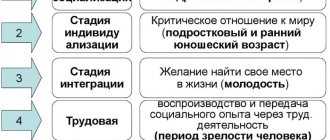One of the most interesting and mysterious areas of our psyche is the world of emotions. Studied for thousands of years by scientists from various fields of knowledge, it still keeps many of its secrets and mysteries. Emotions permeate our entire life, making it bright, rich, sometimes tremulous and tender, sometimes filled with unbearable burning pain. Yes, they are this life itself, because where feelings disappear, human existence ends.
It is psychology that most fully reveals the essence of this area of the human psyche - the only science that has managed to organically link together the physiological basis and manifestations of emotional states.
Concept of emotions and feelings
Whatever a person does, everything evokes a certain attitude in him, expressed in experiences: he likes something, and something causes dissatisfaction, but it is difficult to find something completely indifferent.
Emotions are a positive value, since human life is impossible without experiences. People who do not show their emotions and feelings are very different from those around them and resemble a machine: they cannot be happy, afraid, angry or love. It is the absence of experiences that distinguishes biorobots from people. Emotions are a person’s biased attitude towards the world around him, towards what happens to him. The experience of this relationship is an emotion or feeling. Emotions express acceptance or rejection of what is happening to a person in a given situation.
Conditions, objects and phenomena that contribute to the satisfaction of needs and the achievement of goals cause positive emotions: pleasure, joy, interest, etc. Situations that are perceived by a person as preventing the satisfaction of needs cause negative emotions: anger, sadness, fear, etc.
Emotions are a mental reflection in the form of direct, biased experience, the vital meaning of phenomena and situations, determined by the relationship of their objective properties to the needs of the subject. (Shapar V.B. Newest psychological dictionary).
Emotions are subjective reactions of a person to the influence of external and internal stimuli, reflecting in the form of experiences their personal significance for the subject and manifesting themselves in the form of pleasure (displeasure).
Emotions are a special class of mental phenomena that occur in the form of experiences that reflect a person’s attitude towards the satisfaction or dissatisfaction of his current needs. (Gamezo M.V.)
Thus, the necessary conditions for the emergence of emotions are:
- presence of needs,
— knowledge about the features of a given situation from the point of view of the possibility of satisfying them.
Emotions are manifested in facial expressions , gestures, voice intonations, motor reactions, speech, etc. (expression is the external manifestation of emotions), as well as in physiological phenomena: changes in breathing, heartbeat, increased blood pressure, etc. (impression is the manifestation of emotions in the internal plane).
An experience is any experienced emotionally charged state and phenomenon of reality, directly represented in a person’s mind and acting for him as an event in his own life.
Feelings are the most stable human experiences that arise when social needs are satisfied or dissatisfied (love, pride, hatred, etc.). (Gamezo M.V.)
A feeling is a person’s expression of his positive or negative, i.e. emotional-evaluative, relatively stable attitude towards any objects (people, animals, things). (Ilyin E.P. Psychology, St. Petersburg, 2004)
Thus the feelings:
- more stable, long-lasting compared to emotions;
- expressed through certain emotions;
— have distinctive features: awareness, objectivity, generalization.
Recent Entries
- 1. Features of psychology as a science, its tasks
- Types of student activities
- General concept of intelligence
- General characteristics of a person’s motivational sphere
- Diagnosis of selectivity of attention
- Conflicts as the struggle of animals for vital resources
- Subject and method of pedagogical conflictology
- Dr. Freud and his teachings
- Social ecology is a science and educational subject in the professional training of social work specialists
- Analysis of case studies of therapy
- Development of Russian psychology in the 19th century
- Basic principles and methods of managerial psychology 2
- Coping with difficult life situations
- Guidelines for conducting practical classes in sections 1−3 of the discipline “Psychology”
- in the course "Psychology" 2
Functions of emotions
Table 1
Functions of emotions
| Gamezo M.V. | Ilyin E.P. |
|
|
Let us consider in detail the functions of emotions in the understanding of Gamezo M.V.
The reflective-evaluative function allows you to generally reflect and evaluate an event before it is determined at the level of consciousness (in thinking).
The signaling function consists of notifying the body (nervous system) and other people about the state of the subject’s needs (their satisfaction or dissatisfaction).
The protective function of emotions is to warn the subject about real or imaginary danger (fear, disgust, etc.). These emotions are stored in memory and in a certain situation are extracted from it in order to perform a protective function.
The executive function is expressed in the fact that emotions are internal regulators of any activity. Optimal productivity occurs with an average level of emotions (O. Hebb).
The mobilizing function lies in the fact that emotions can be stimulants (motives) of activity and behavior, and also influence changes in motives. Emotions are a subjective form of existence of motivation.
The compensatory function allows you to compensate for the shortcomings of other mental phenomena. For example, in a teacher’s monologue speech, emotional elements of speech are useful. They not only decorate speech, but also contribute to a deeper understanding of the material.
The disorganizing function of emotions can manifest itself in disruption of behavior, activity, memory, thinking and other processes due to strong emotions, especially negative ones. However, this does not always happen.
Thus, with the help of emotions, we determine the significance of external influences and evaluate our own behavior. All our victories and defeats are emotionally colored. Many life events are remembered precisely because of the emotions experienced. Knowledge of the emotional characteristics of another person contributes to the understanding of his actions and actions, the establishment of adequate forms and methods of communication with him, and the rational organization of activities.
Diagnostics
Emotions in psychology, classification and their functional role, are studied with the aim of determining the mood and general state of a person, identifying brightly colored negative reactions and finding ways out of them, self-control of one’s emotional background and its stability.
Diagnosis of emotions is carried out in several areas:
- Observation - physiological changes in the body are analyzed (blood pressure, pulse, skin temperature, analysis of facial expressions, speech).
- Questionnaires are the most common and informative diagnostic method aimed at identifying a person’s leading emotions using specially designed tests. The method is also used to determine self-assessment of emotional state.
- To establish leading emotions, it was developed differential scale by K. Izard (1976). It consists of 10 fundamental emotions, characterized by 3 meanings, with which one’s own feelings are compared. These values are assigned points, after which the well-being coefficient is calculated.
- M. Luscher color test (1949) – connects the emotional state with the light sensitivity of the eyes. It assumes that certain emotions are associated with certain colors, and a person must correlate 1 of 8 colors with a given question. Warm shades (red-yellow) indicate the presence of positive emotions and good mood, cold tones signal the presence of negative emotions.
- The scale for assessing the significance of emotions according to B.I. Dodonov (1977) is a ranking of preferences in emotions according to 10 criteria (from the most significant to the least significant) in order to determine the prevailing needs (biological, cognitive, social).
For young children, the most commonly used method for assessing emotional stability using drawings (methods Cactus, Family Drawing).
- Questioning is a type of survey conducted in writing by filling out questionnaire forms. It is often used to survey a group of people both statically (once) and dynamically (repeated survey after a certain time).
You can undergo a clinical psychological or neuropsychological examination in Moscow at the following clinics:
- M-Vita, st. Zelenogradskaya, 39, building 1 – from 1500 to 2500 rubles;
- ABC medicine, st. Stoletova, 19 – 1100 rubles;
- Alliancek KRK, st. Tsyurupy, 1, building 6 – 4000 rubles;
- Family clinic, st. Pervomaiskaya, 42 – 3300 rubles;
- Treatment center, st. Timur Frunze, 15/1 – 2900 rub.
You can consult a psychotherapist at a private doctor or at one of the clinics in Moscow:
- Capital, Prospekt Mira, 12, building 3 – 3000 rubles;
- M-Vita, st. Zelenogradskaya, 39, building 1 – 2000 rubles;
- Fomina Clinic, st. Dolgorukovskaya, 17, building 1 – 6000 rubles;
- Alliancek KRK, st. Tsyurupy, 1, building 6 – 3000 rub.
Physiological basis of emotions and feelings
Emotions are the result of brain activity, the complex work of the cortex, subcortex and autonomic nervous system . The leading role belongs to the cortex. Objects reflected in consciousness cause strong foci of excitation in the cortex, which are transmitted to the brainstem and subcortex, where the centers that control the autonomic nervous system and regulate the functioning of internal organs are located. The subcortex reacts primarily to stimuli, which leads to changes in the rhythm of breathing, cardiac activity, skeletal muscles and body muscles, the work of the external glands (salivary, lacrimal, sweat) and internal secretion .
The cortex regulates the actions of the subcortex, so a person restrains hunger and socially unacceptable impulses. But if the cortex is weakened (due to intoxication, overwork, etc.), then the person loses the ability to restrain himself.
In 1950, D. Olds and P. Milner, in experiments on animals, discovered centers of pleasure and centers of suffering, and later centers of hunger, thirst, etc., which created an emotional map of the brain. At the same time, the centers of suffering, being located in different parts of the brain, form a single system. Therefore, negative emotions are experienced rather monotonously. The pleasure centers of such a system do not form and positive emotions are experienced more differentiated.
Next in the table we will present separately the physiological basis of feelings and the mechanisms of emotions.
table 2
Physiological mechanisms of emotions and feelings
| Physiological basis of feelings | Physiological basis of emotions |
| Leading role: - the cerebral cortex, which has an inhibitory effect on the subcortical centers, regulates the flow and expression of feelings and emotions; - 2nd signal system; word: - a signal for the emergence of feelings, emotions; - the basis for the formation of higher feelings. | Emotions: - are caused by excitation of subcortical centers and the autonomic nervous system; — cause changes: — in the circulatory organs; - in the respiratory organs; - in the digestive organs; - affect thinking, memory, coordination of movements, productivity. |
Theories of emotions
Information theory P.V. Simonova : emotions arise when there is a mismatch between a vital need and the possibility of satisfying it (with a lack of information necessary to achieve the goal); A person's awareness of the means to satisfy a need can relieve emotions.
L. Festinger's cognitive theory : positive emotions - if expectations are confirmed. Negative – if expectations are not confirmed
Biological theory P.K. Anokhina : positive emotions arise if the result of an action matches or exceeds the expected result. The discrepancy leads to anxiety and the search for new combinations that would lead to positive emotions.
Classification of types of emotional phenomena
Man is the most emotional creature. He is capable of experiencing tens of thousands of shades of emotions at different periods of his life, but a person’s vocabulary is limited to 5-6 thousand words, which are not enough to express all these shades. There is no single classification of emotions. Let's present the most common classification in psychology (see Fig. 1).
| Types of emotional phenomena (according to the degree of awareness, objectivity, stability and generality) |
| EMOTIONS (according to strength, speed of occurrence and awareness of the causes of occurrence) 1. Sensual tone; 2. Emotions themselves (basic): joy, surprise, interest, sadness, anger, disgust, contempt, fear, shame, guilt; 3. Moods; 4. Affects; 5. Stress. |
| FEELINGS 1. Moral; 2. Intellectual; 3. Aesthetic; 4. Practical. PASSIONS |
Rice. 1. Types of emotional phenomena
In Table 3 we give definitions to the emotional phenomena indicated in the classification.
Table 3
Types of emotional phenomena
| Concept | Definition of the concept. Purpose of emotion |
| Sensual tone - | - these are positive or negative experiences that accompany certain vital influences (taste, temperature, etc.) and encourage the individual to maintain or eliminate them. Many human sensations have a certain emotional connotation. We don’t just smell or taste something, we perceive it as pleasant or unpleasant. When we feel warm or cold, we simultaneously experience pleasure or displeasure. Images of perception, memory, thinking, imagination are also emotionally charged. A.N. Leontiev called this phenomenon “bias” of reflection and considered it one of the essential features of human cognition. |
| Basic emotions - | - these are emotions that are situational in nature, expressing an evaluative attitude towards developing or possible situations. They are short-term, quite strongly expressed, and the reasons for their occurrence are quite well understood by humans. These emotions have been well studied and 10 main ones have been identified among them (K. Izard). Each basic emotion underlies a whole spectrum of states. Almost all of them can be read by facial expressions. |
| Joy - | - a positive emotional experience associated with the ability to sufficiently fully satisfy an actual need. Serves to establish contacts with people, retain useful thoughts and actions in memory, and eliminate the negative impact of negative emotions. |
| Astonishment - | - an emotional reaction to sudden circumstances that does not have a clearly defined positive or negative sign. Serves to extinguish the existing activity of the nervous system and to prepare the body for activity in a new situation. |
| Interest - | - an emotional reaction to something new, a source of motives for learning and creativity. |
| Sadness (grief, suffering) - | - an emotional signal of the inability to satisfy vital needs. It manifests itself in chained thoughts to the object of sadness, tears, bitterness in the mouth. Sadness slows down the pace of life, gives you the opportunity to look back, see the future, and in this sense is an adequate state. |
| Anger - | - an emotional experience, negative in sign, usually occurring in the form of affect and caused by the sudden emergence of a serious obstacle to the satisfaction of an extremely important need for a person (pain, restriction of freedom, physical influence, etc.). Anger ensures the mobilization of all the forces of the body to fight. |
| Fear - | - a negative emotion that manifests itself when a person receives information about a real or imagined danger; emotional reaction to danger. Fear is a way of activity and protection from strong shocks. |
| Disgust - | - a negative emotional experience caused by objects (objects, people, circumstances, etc.), contact with which comes into sharp conflict with the ideological, moral or aesthetic principles and attitudes of a person. In evolution it arose as a defense against poisoning. |
| Contempt - | - a negative emotion that arises in interpersonal relationships and is generated by a mismatch in life positions, views and behavior with the life positions, views and behavior of the object of experience. Contempt is the rejection of another person. |
| Shame - | - a social emotion that expresses the subject’s awareness of the inconsistency of his actions, thoughts, appearance with the expectations of other people and his own ideas. The experience of shame is an indicator of condemnation of one’s actions and the desire to correct them. |
| Guilt - | - an emotion that arises when moral and ethical standards . Without the individual’s acceptance of social norms, social norms do not arise. Guilt expresses a person’s condemnation of his action and himself, accompanied by a decrease in self-esteem, repentance and a desire to improve. Experiencing the emotion of guilt is similar to experiencing shame. |
| Mood - | - a stable, weakly expressed, relatively long-lasting experience that colors a person’s behavior and activity for a considerable time. The reasons are not always clear to the person experiencing them, but they always exist and can be determined. Mood depends on health, self-esteem, level of aspirations, character, etc. It is an emotional reaction not to the direct impact of certain events, but to their significance in a person’s life in the context of his life plans, interests and expectations. Mood is an individual’s unconscious assessment of how favorable circumstances are for him. Can be joyful and sad, cheerful and depressed, cheerful and depressed, calm and irritated. It indicates that a person is determined and ready to react in a certain way. S.L. Rubinstein believed that, 1) it is not objective, but personal; 2) this is not a special experience dedicated to some particular event, but a diffuse, general state. Other people, their attitude, their attention, care, even just their facial expressions shape a person’s mood. Repeated often, mood can become a stable personality trait (pessimists and optimists). The older a person is, the more stable and constant his mood becomes. Mood leaves a significant imprint on a person’s behavior: it can stimulate or suppress his activity. When a positive mood prevails, a person easily experiences temporary failures and disappointments. Therefore, it is important to be able to manage your mood (through reflection, self-knowledge, introspection, mastery of the means of mental self-regulation). |
| Affect - | - an emotional experience that arises suddenly, quickly takes possession of a person, proceeds rapidly, characterized by a change in consciousness, a violation of volitional control. It occurs in extreme conditions, when a person does not see a constructive way out of an existing situation. The cause of affect is most often a conflict between a person’s strong attraction, desire, desire for something and the objective impossibility of satisfying the urges that arise. When affected, the volume of consciousness narrows and is limited to a small number of ideas and perceptions that are closely related to the emotion being experienced, and all the forces of the body are mobilized. The forms of its manifestation are anger, delight, ecstasy, horror, despair or stupor, stiffness. The affect ends with a loss of strength, fatigue and even fainting, since extremely strong excitement, having passed the limit of the working capacity of nerve cells, is replaced by unconditional protective inhibition, emotional shock. Impaired consciousness can lead to the inability to subsequently remember episodes of the event that caused the affect, or the event as a whole ( complete amnesia ). Expressing emotions in the form of affect is not desirable. With the exception of rare cases of the development of pathological affect, accompanied by deep clouding of consciousness, a person is responsible for his actions committed in a state of passion. It would be wrong to think that affect is completely uncontrollable. Despite the apparent suddenness, it has certain stages of development. And if at the final stages, when a person completely loses control over himself, it is almost impossible to stop, then in the beginning any normal person can do this. Of course, this requires enormous volitional efforts, all the more significant the more the affective state has developed. The most important thing here is to delay the onset of affect, “extinguish” the outbreak, restrain yourself, and not lose control over your behavior. There are special techniques that help a person cope with a strong emotion and prevent it from turning into passion. To do this, it is recommended to notice and realize an unwanted emotion in time, analyze its origins, release muscle tension and relax using the following techniques: breathe deeply and rhythmically; attract a pre-prepared “duty image” of a pleasant event in your life; try to look at yourself from the outside, separate the experience itself from the object that “caused it,” etc. Thus, affect can be prevented, but this requires endurance, self-control, special training, and the development of moral qualities of the individual. Almost all experienced affects are remembered. Their influence on the psyche is so great that often even a memory causes a reaction of trace affect. A person, in his memory, seems to be reliving it. Having studied the mechanism of trace affect, A.R. Luria in the early 1930s. created the first lie detector. Its action was based on the fact that when naming words associated with experienced affect, a person unconsciously exhibits a complex of vegetative and motor reactions. Initially, the lie detector was used to answer questions during the interrogation of defendants and witnesses. Now it is not used in domestic criminology, firstly, for ethical reasons, and secondly, because of the possibility of obtaining unreliable information, i.e. the same type of change in vegetative indicators occurs with different emotions. |
| Stress – Physiological stress – Information stress – Emotional stress – Depression – | - neuropsychic stress caused by extremely strong extreme exposure; the state of the necessary total mobilization of the body’s forces and mental activity to find a way out of a very difficult, dangerous situation (Enikeev M.I.). - this is a nonspecific response of the body to any demand presented to it, which helps it adapt to the difficulty that has arisen and cope with it (G. Selye). With the help of stress, the body mobilizes itself entirely to adapt to a situation that cannot be dealt with by ordinary means. Stress is a natural part of human life, and not all stress is harmful. Stress, according to Hans Selye (1907-1982), a Canadian biologist, physician and psychologist, is a nonspecific response of the body to any demand presented to it (adaptation syndrome). It manifests itself in incoherence of speech, confusion, memory impairment, etc. It occurs in three stages (G. Selye): 1) anxiety – mobilization of all the body’s defenses to adapt to a situation that cannot be dealt with by conventional means (eustress). This is manifested in the intensification of the work of internal organs, in improving the volume and stability of attention, and in increasing efficiency. A person is internally ready to overcome obstacles; he is characterized by faith in success. But already at this stage, increased excitation from the centers of the brain spreads to the peripheral parts and internal organs; 2) stabilization - the situation is consolidated, there is an overexpenditure of adaptive forces (distress). All systems of the body, brought out of balance, begin to function at the maximum level. Externally, the behavior differs little from the norm, everything seems to be getting better, but internally there is an overexpenditure of adaptation reserves. If the effect of stress factors continues, the third stage begins; 3) exhaustion, resulting in deterioration in health, illness (nervous or somatic ) and even death. A feature of stress is that a person reacts not only to danger or a real worsening of the situation, but also to the threat of it. For example, stress often arises not only in the situation of job loss or divorce, but also in the fear of losing a job or in anxious anticipation of the breakdown of a marital relationship. Behavior under stress is different from affective behavior. Under stress, a person, as a rule, can control his emotions, analyze the situation, and make adequate decisions. If it lasts for a long time, serious problems arise. People experience stress in different ways (lion stress (danger spurs a person, forces him to act boldly and courageously; activity increases, forces are mobilized, activity efficiency increases) or rabbit stress (can cause disorganization of activity, a sharp drop in its effectiveness, passivity and general braking)). Not a single person manages to live and work without experiencing stress. Everyone experiences severe life losses, conflicts, and stress when performing difficult or responsible work from time to time. Some people cope with stress more easily than others, e.g. are stress resistant. Based on the type of stressor and the nature of its influence, stress is distinguished between physiological and psychological. — the body’s reaction to a threatening situation (pain, blood loss, breathing problems, etc.). Psychological stress is divided into informational and emotional. - a type of stress that occurs in a situation of significant information overload, when a person cannot cope with the task of processing incoming information and does not have time to make the right decisions at the required pace (especially with high responsibility for the consequences of decisions made). This type of stress is characterized by a decrease in the volume and concentration of attention, increased distractibility, inability to concentrate, memory deterioration, an increase in the number of errors and wrong decisions, thinking becomes confused, unable to assess existing conditions or predict results. — a type of stress (R. Lazarus) that occurs when a person is emotionally overloaded; Most authors associate its occurrence with situations of threat, resentment, danger, etc. The consequences of this type of stress are the following. Tension, anxiety, and restlessness increase. Painful suspiciousness appears, the feeling of health disappears. Sleep gets worse. The consumption of drugs and stimulants is increasing. Personality characteristics change: neat people can become slobs, sociable people can become gloomy and withdrawn. Life goals can be abandoned, hobbies abandoned. Depression, feelings of helplessness, or emotional outbursts may occur. Responsibility for what happens is often placed on other people. Thoughts and phrases containing a threat of suicide arise. — an affective state characterized by a negative emotional background, a change in the motivational sphere (decreased or complete lack of interest in the world around us, etc.), cognitive ideas and general passivity of behavior. Ways to reduce the psychotraumatic impact of stressful situations: 1) rationalization of an impending negative event, its comprehensive analysis, reducing the degree of its uncertainty, getting used to it, preliminary adjoining to it, eliminating the effect of surprise; 2) depreciation, reduction in the significance of a stressful situation; 3) extreme mental intensification of possible negative consequences of upcoming events (reality may turn out to be easier than expected crisis situations). |
| Emotional burnout - | — the mental state of healthy people who are in intensive and close communication with clients and patients in an emotionally charged atmosphere when providing professional assistance; manifests itself in emotional and/or physical devastation: a feeling of emotional tension and a feeling of emptiness; in this case, an indifferent and even negative attitude arises towards people served by the nature of their work, the consequences of which are irritability and conflict. Emotional burnout also leads to a decrease in labor productivity, self-esteem competence, increased dissatisfaction with oneself and a negative attitude towards oneself as an individual. Reasons : monotony and monotony of work, inadequate management, lack of conditions for career and professional growth, professional inconsistency, socio-psychological disadaptation, etc. Internal conditions influencing the occurrence of emotional burnout: accentuations of a certain type of character, high anxiety, high aggressiveness, conformity, inadequate level of aspirations, etc. Emotional burnout hinders professional and personal growth and, like stress, leads to psychosomatic disorders. Means of prevention: optimization of working conditions, psychological correction of emotional disorders in the early stages, etc. |
| Anxiety - | - a state of unconscious threat, a feeling of apprehension and anxious anticipation, or a feeling of vague anxiety. |
| Anxiety - | — a person’s tendency to experience anxiety, a state of conscious or unconscious anticipation of the impact of a stressor, frustrator; a fairly stable personality trait. |
| Panic - | - a motivational mental state associated with the manifestation of mass fear of a real or imaginary threat, a state of periodic fear, horror, growing in the process of mutual infection by them. |
| Frustration - | - an extremely emotionally intense negative state associated with the emergence of an obstacle that is insurmountable for a given individual in achieving a goal that is significant to him. (Enikeev M.I.) If the causes of frustration cannot be eliminated, a deep depressive state may occur, associated with significant and prolonged disorganization of the psyche (weakening of memory, ability to think logically, etc.). It manifests itself in unbearably painful, oppressive mental stress, in a feeling of despair, hopelessness, extreme aggressiveness towards the frustrator. The depth depends on the significance of the target being blocked and its proximity. Neuroses and character deformations may also occur: persistent self-doubt, low self-esteem and level of aspirations, rigidity (inability to change behavior programs). The intractability of frustration is due to the fact that a person cannot eliminate the causes of this condition. Therefore, he looks for some kind of compensating outlets, goes into the world of dreams, and sometimes returns to earlier stages of mental development (regresses). A person’s resistance to frustrators depends on the degree of his emotional excitability, type of temperament , and experience of interaction with such factors. What to do? Behave rationally, lower your level of claims, come to terms with difficulties, etc. |
| Euphoria - | - a mental state (mood), which is characterized by carelessness, serenity, complacency, carelessness and at the same time an indifferent attitude towards the serious aspects and phenomena of life. Euphoria is caused by alcohol, drugs, spectators for artists, etc. |
Feelings
Feelings are the most developed and complex form of emotional processes in a person; they are formed under the conditions of his life in society.
Higher feelings are a special form of experience associated with more complex spiritual needs, which contain all the richness of truly human relationships. The objects of these feelings are individuals, groups of people, cultural objects, works of art and literature. The education of higher feelings is of a cultural and historical nature, associated with the awareness and acceptance of universal human values, knowledge of national characteristics, folk traditions and rituals (MSPU).
Kinds
Emotions in psychology, the classification of which (like the concept itself) does not have a universal approach, were studied long before the formation of science itself. The ancient Greeks divided emotions into 2 positive (joy, desire) and 2 negative (fear, sadness) reactions, from which they identified many secondary ones.
Later, some scientists (W. Wundt, B. Spinoza), in attempts to create a unified classification system, came to the conclusion that a person experiences such a number of emotions that it is simply impossible to differentiate in any way.
Therefore, in psychology there are quite a few classifications of this mental process, the most famous of which are:
| Author of the classification | Year of creation | Classification feature | Classification | brief information |
| T. Reed | 1780s | By source of occurrence | With an animal origin | Thirst, desire, appetite. |
| With a mechanical start | Habits, instincts. | |||
| With a rational start | Self-love, shame, duty. | |||
| I. Kant | 1780s | By influence on activity | Stenic | They are a stimulus to increase the vital activity of the body (admiration, joy). |
| Asthenic | Reduce human vital activity (fear, sadness). | |||
| T. Brown | 1820 | By time of occurrence | Retrospective | Previously passed. |
| Direct | Emerging at the moment. | |||
| Prospective | May arise in the future. | |||
| G. Spencer | 1850s | Based on occurrence | Presentative | They appear as a result of external influence (anger at someone, fear of something). |
| Representative | They are not tied to a specific stimulus and are caused by poetry. | |||
| Presentational-representational | Simple (fear, joy). | |||
| Distracted (higher) | They are formed without external influence (a sense of duty, justice). | |||
| B. Dodonov | 1978 | By functionality | Praxic | Caused by the desire to achieve success in any activity (in the work process, in school). |
| Altruistic | Concern for someone, a desire to bring joy, to provide help. | |||
| Gloric | The desire to become famous and establish yourself. | |||
| Pugnic | The desire to fight for something, to overcome obstacles. | |||
| Communication | Need for communication. | |||
| Aesthetic | The need to admire the beautiful. | |||
| Active | The desire to collect something, to collect. | |||
| Gnostic | The need for knowledge, learning something. | |||
| Hedonistic | The need for physical and mental comfort. | |||
| Romantic | Thirst for the unusual, mystical, mysterious. | |||
| R. Plutchik | 1980 | By manifestation | Basic (primary) or simple | He identified 8 basic emotions: sadness, joy, fear, anger, trust, expectation, surprise, displeasure. |
| Secondary (complex) | They arise as a result of a combination of 2 or more primary emotions (horror, disappointment, boredom, interest). | |||
| V. Viliunas | 1986 | According to the method of occurrence | Leading (primary) | They arise when reacting to a specific object or situation (admiration, fear, anger). |
| Situational (secondary) | They are derivatives of primary emotions (disappointment, hostility, respect). | |||
| L. Kulikov | 1997 | According to the degree of manifestation | Self-evaluative | To assess the internal state (shame, pride, sadness). |
| Activation | Motivating emotions (joy, excitement, cheerfulness). | |||
| Tension | Emotions accompanying a state of tension (fear, anger, irritation). |










